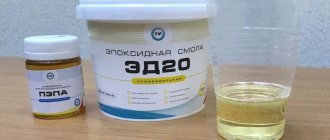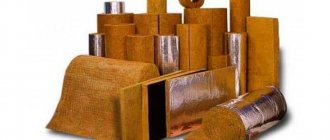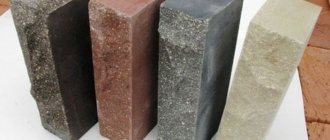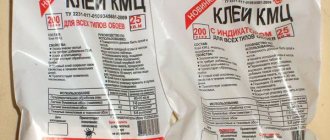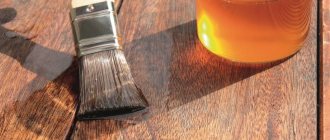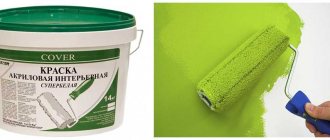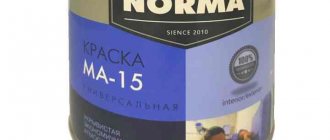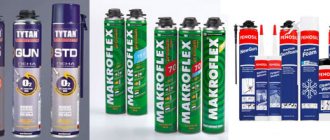Resins can be obtained from natural elements or industrially, the latter are called synthetic. They are more affordable and give reliable results when used. Phenol-formaldehyde resin is a popular type of material that is used in construction and other works. The features of formaldehyde resin will be discussed in detail below.
Resin properties
The resin with a base of phenol and formaldehyde is of the synthetic type. The chemical equation of the element is C6H3(OH)-CH2-]n. A. Bayer was the first to develop the substance, realizing that the reaction of phenol and formaldehyde when heated produces the formation of water and polymer. That experiment produced a fragile element, after which it was improved, now various substances are added to the composition to obtain better properties.
Phenol resin chemical properties are as follows:
- Structural characteristics – liquid or solid;
- Formed in an acidic or alkaline environment;
- Has a high degree of electrical insulation;
- Resistance to mechanical loads;
- Rust resistance;
- Soluble in alkalis, hydrocarbon, ketone, chloride type diluent.
The resin with a base of phenol and formaldehyde is of the synthetic type.
Formation and structure[edit]
Phenol-formaldehyde resins, as a group, are formed by a step-step polymerization reaction that can be acid- or base-catalyzed. Since formaldehyde exists predominantly in solution as a dynamic equilibrium of methylene glycol oligomers, the concentration of the reactive
Form of formaldehyde depends on temperature and pH.
Phenol reacts with formaldehyde at the ortho and para sites (sites 2, 4 and 6), allowing up to 3 formaldehyde units to attach to the ring. The initial reaction in all cases involves the formation of hydroxymethylphenol:
HOC 6 H 5 + CH 2 O → HOC 6 H 4 CH 2 OH
The hydroxymethyl group is capable of reacting either with another free ortho or para center or with another hydroxymethyl group. The first reaction gives a methylene bridge, and the second gives an ether bridge:
HOC 6 H 4 CH 2 OH + HOC 6 H 5 → (HOC 6 H 4 ) 2 CH 2 + H 2 O 2 HOC 6 H 4 CH 2 OH → (HOC 6 H 4 CH 2 ) 2 O + H 2 O
The diphenol (HOC 6 H 4 ) 2 CH 2 (sometimes called a "dimer") is called bisphenol F, which is an important monomer in the production of epoxy resins. Bisphenol-F can further bind to form oligomers of tri-, tetra-, and higher phenols.
Resol resins
This type of resin is distinguished by the fact that when heated and for a long period of storage, it acquires an infusible property and also does not dissolve. In order to obtain resins called resoles during production, they go through the following stages:
- Resols undergo melting stages or dissolve in an alcohol, acetone or aqueous-alkaline solution. The method produces a mixture of low molecular weight fusions of reaction elements;
- Resitols are obtained from substances called resols. When they are stored for a long time or exposed to high temperatures. They do not dissolve in alcohol or acetone solutions, they swell only slightly, but soften when heated;
- Resites, at this stage there is no swelling in solvents, and softening does not occur either.
This type of resin is distinguished by the fact that when heated and for a long period of storage, it acquires an infusible property and also does not dissolve.
Preface
Phenol-formaldehyde resin has been produced industrially since 1912 under the name Bakelite.
Like many other new products, Bakelite was initially viewed with skepticism, and it was difficult for it to compete in the market with long-known materials. The situation quickly changed when its valuable properties were discovered - bakelite turned out to be an excellent electrical insulating material, which at the same time has high strength. Today in our homes we hardly see sockets, plugs and electrical switches made of porcelain. They were replaced by products made from thermoset plastics. Bakelite and related plastics have also taken pride of place in mechanical engineering, automotive manufacturing and other industries.
Application of material
Phenol-formaldehyde resin is used in various fields of activity; with its help, different classes of plastic are produced in industry. Use in everyday life is popular; different plastics are obtained with different types of exposure. Plastic is often used in medicine.
Phenol-formaldehyde is used in the production of varnish products, adhesive solutions, and sealants.
So it is used to produce the following products:
- Brake pads in trains, car parts, etc.;
- Abrasive devices;
- Parts of electrical appliances;
- Smartphone housing parts;
- In the radio industry;
- For the manufacture of weapons and other military equipment;
- For making cookware that is not exposed to heat;
- For jewelry, souvenirs;
- Other.
Resin is not used for products that will come into direct contact with food.
Phenol-formaldehyde resin is used in various fields of activity; with its help, different classes of plastic are produced in industry.
Applications [edit]
Phenolic resins are found in a variety of industrial products. Phenolic laminates are made by impregnating one or more layers of base material, such as paper, fiberglass, or cotton, with phenolic resin and laminating the resin-saturated base material under heat and pressure. During this process, the resin is completely polymerized (cured), forming a thermoset polymer matrix. The choice of base material depends on the intended use of the finished product. Paper phenolics are used in the production of electrical components such as pegboard, in household laminates, and in paper composite panels. Glass phenolic resins are particularly well suited for use in the high speed bearing market. Phenolic microbeads are used to control density. The binder in conventional (organic) brake pads, brake pads and clutch discs is phenolic resin. Synthetic resin bonded paper, made from phenolic resin and paper, is used to make countertops. Another use of phenolic resins is in the manufacture of Duroplast, used in Trabant cars.
Phenolic resins are also used to make exterior plywood, commonly known as weather and boil
(WBP) because phenolic resins do not have a melting point, but only a decomposition point in the temperature zone of 220 °C (428 °F) and above.
Phenolic resins are used as a binder in loudspeaker driver suspension components, which are made of fabric.
Top quality billiard balls are made from phenolic resins, as opposed to the polyesters used in less expensive sets.
People sometimes choose fiber-reinforced phenolic resin parts because their coefficient of thermal expansion closely matches that of aluminum used for other parts of the system, as in early computer systems [4] and Duramold.
Dutch art forger Han van Meegeren mixed phenol-formaldehyde into his oil paints before baking the finished canvas to simulate the drying of paint over centuries.
Mechanism of formation of phenol-formaldehyde resins
The mechanism for producing the resin involves combining 1-3 moles of formaldehyde to 1 mole of phenol in 2 ortho positions and a para position. When there is more of the second element, a resol type of substance is produced. If there is more phenol, then the novolac type is formed.
The first stage of the reaction is characterized by the resulting type A resole resin. The presence of methylol groups in this process contributes to the creation of a polycondensation reaction, when monomers transform into polymers. The heating process produces resite.
Phenol alcohol substances, when a lot of phenol is formed by methylol dioxydiphenylmethane. After polycondensation it becomes a novolac resin.
The mechanism for producing the resin involves combining 1-3 moles of formaldehyde to 1 mole of phenol in 2 ortho positions and a para position.
General and structural formulas
The composition of substances can be expressed by the general formula C 6 H 6- n (OH) n
.
The simplest representative of the class has 1 hydroxo group. Its molecular formula is C6H5OH. Structural formula - OH.
If in a phenol molecule 1 hydrogen atom is replaced by a methyl radical, we obtain methylphenol. If we add another benzene ring to it, we get naphthol.
Production of phenol-formaldehyde resin
You can obtain the material using methane and methanol, then formaldehyde is converted, which is combined with phenol. The technological process is performed as follows:
- A 40% formaldehyde solution in a volume of 3 ml is used;
- The solution is mixed with 2 grams of crystalline phenol;
- Add 3 drops of hydrochloric acid;
- After the solution boils, it will become transparent;
- If the reaction should proceed more slowly, then the container is cooled;
- To check the result, you can use alcohol in the resol stage, where it dissolves easily;
- If the solution stands for a long time, the ability to dissolve will disappear and the substance will turn into resitol;
- At the end, the solution heats up and becomes solid, the color turns red.
The product does not burn; it undergoes charring. The fire will turn yellow and an unpleasant smell of phenol will appear.
You can obtain the material using methane and methanol, then formaldehyde is converted, which is combined with phenol.
Technological process for producing phenol-formaldehyde resole resin
Phenol, cresol, xylenol, and cresol-phenol fractions can be selected as raw materials when creating resol resins. Formaldehyde is used in a concentration of 36-40 percent.
Different types of material can be produced. There are liquid and solid types, the latter are used in the manufacture of varnish products. There are other types of resins using urea instead of phenol, and urea resins are also popular.
Formaldehyde is used in a concentration of 36-40 percent.
Links[edit]
- ^ ab A. Garziella, L. A. Pilato, A. Knop, Phenolic resins: chemistry, applications, standardization, safety and ecology, 2nd edition, Springer, 2000.
- Wolfgang Hesse "Phenolic Resins" in Ullmann's Encyclopedia of Industrial Chemistry, 2002, Wiley-VCH, Weinheim. DOI: 10.1002/14356007.a19_371.
- Ralph Dammel (1993). "Fundamentals of novolac chemistry." Resists based on diazonaphthoquinone
. Int. Soc. Optical engineering. ISBN 9780819410191. - JG Ferguson, we are Grutzner, DC Koehler, RS Skinner, MT Skubiak and DH Wetherell. "ESS No. 1 Apparatus and Equipment". Bell System Technical Journal. 1964. p. 2417.
- “Resource What is tufnol?” . ahistoryoftufnol.org
. - Husse AC; Miller PD; Volk TJ (July 2006). "White rot fungi demonstrate first biodegradation of phenolic resin." Environmental Science and Technology
.
40
(13):4196–9. Bibcode: 2006EnST…40.4196G. DOI: 10.1021/es060408h. PMID 16856735.
Environmental aspects
For the environment, the use of toxic components in resin production becomes a danger. The problem is the harmfulness of toxic elements, namely the process of their disposal. So SanPiN monitors the use of elements and the quantity that is used.
For the environment, the use of toxic components in resin production becomes a danger.
What are phenolics
Phenolics are plastic materials obtained by combining phenol-formaldehyde resin with various components. The reaction occurs at high temperatures, and the choice of components depends on the final product.
This category of plastics includes phenolic-bakelite glue and various plastic objects used in everyday life and household activities. Phenolic plastics are used in the production of technical and automotive components.
Now, due to improvements in production processes, the final product contains harmful components in very low and insignificant quantities.
Material damage
The positive aspects of using resin are accompanied by the harm that the substances can cause to a person’s physical health. Phenol and formaldehyde are toxic elements. They are characterized by the following harmful properties:
- Have a negative effect on the nervous system of the body;
- Promote the appearance of rashes and dermatitis;
- May cause an allergic reaction and bronchial asthma.
Not only the amount of substances used in production is regulated, but also the safety of work. Because of this, phenol-formaldehyde resin is more harmful than epoxy.
The positive aspects of using resin are accompanied by the harm that the substances can cause to a person’s physical health.
Manufacturing process
Phenol, ammonia and formaldehyde are added to the device, a heating process is carried out, and the temperature is set to 80 degrees. When the desired temperature is reached, the steam supply stops. In the boiler, the temperature increases further to 100 degrees, promoting the continuation of the reaction. The result is checked by the degree of turbidity of the substance; when the result reaches 75-80 degrees, the process is completed.
Further drying of the resin can be carried out if it is necessary to obtain a solid version. If a liquid type is needed, the process is completed after receiving condensate and checking the result. Then the water is separated from the resulting resin. Resol is poured into a container.
Phenol, ammonia and formaldehyde are added to the device, a heating process is carried out, and the temperature is set to 80 degrees.
Preparation of phenol
Phenol is found in small quantities in coal tar. But the need for the substance is so great that this source is not enough.
Various methods have been developed to obtain:
- According to the scheme C6H6 —— C6H5Cl —— C6H5OH. The disadvantage of the method is the strict conditions for replacing chlorine with a hydroxo group. Reactions have to be carried out at high temperature and pressure.
- Benzene and propylene are used to produce, resulting in cumene. Then cumene is oxidized, resulting in valuable products - phenol, acetone.
Cresol-formaldehyde resins
This type of resin is produced using para-, ortho- and meta-cresol. Cresol and formaldehyde are taken in equal proportions. If there is more formaldehyde, then resol resins are produced, if there is cresol, then novolac resins. The production process is the same as the production of phenol-formaldehyde resins.
The production process is the same as the production of phenol-formaldehyde resins.
Liquid alcohol-free bakelite resins
In the industrial production of electrical insulating equipment, this type of resin is often used. The OF and OK types are selected. This is due to the possibility of not using expensive ethyl alcohol (ethanol).
The resin is obtained by condensing phenol with formaldehyde; an ammonia type of catalyst is also required. The manufacturing devices used are the same as those used for working with dry resins. A lower temperature regime is used, up to 85 degrees. There is no drying step; water is simply removed from the resin.
The resin is obtained by condensing phenol with formaldehyde; an ammonia type of catalyst is also required.
Slightly soluble phenol-formaldehyde resins
When the condensation reaction of phenol and formaldehyde is used, oil-insoluble resins are obtained. Replacing phenol with its derivatives facilitates the production of oil-soluble resins. Mixing elements with oils makes it possible to obtain high-quality varnishes.
You can also get oil-based enamel varnishes, which are used for enameling wires. It is common to create different reactions to produce resins used in electrical insulation work.
Mixing elements with oils makes it possible to obtain high-quality varnishes.
Pipes and products made of textofaolite
In some cases, faolite currently produced cannot be used due to insufficient mechanical strength. Reinforcement or textolization of faolite with fabric makes it possible to obtain a material with significantly improved mechanical properties.
Phaolite pipes are produced in the usual way. The uncured faolite product is tightly wrapped with strips of fabric coated with bakelite varnish. If re-application of faolite is not required, then textofaolite is cured in this form.
In this way, pipes and frames of various diameters are obtained, from which devices or exhaust pipes are subsequently mounted.
Esterified resins
Esterification helps the resin combine with vegetable oils and other types of resins. The process is carried out using butyl alcohol. So, under certain conditions, it is possible, for example, to obtain RB butoxycresol-formaldehyde resin.
The resin is produced as a solution in butanol and has the properties described below:
- Colorless liquid with a yellow-red tint in appearance;
- The viscosity level of VZ4 at 2-degree exposure is 100-300c.
This type of material is used in a 60% solution for the manufacture of electrical insulating varnish products (Fl-98, PE-933).
The process is carried out using butyl alcohol.
Phenol-formaldehyde resin can improve the quality of a variety of products; it is used to produce various materials. It has a number of positive properties. But it is a dangerous substance, so during production the rules of Sanitary Regulations and Regulations must be observed. Her invention was an important link in the production of a variety of materials.
